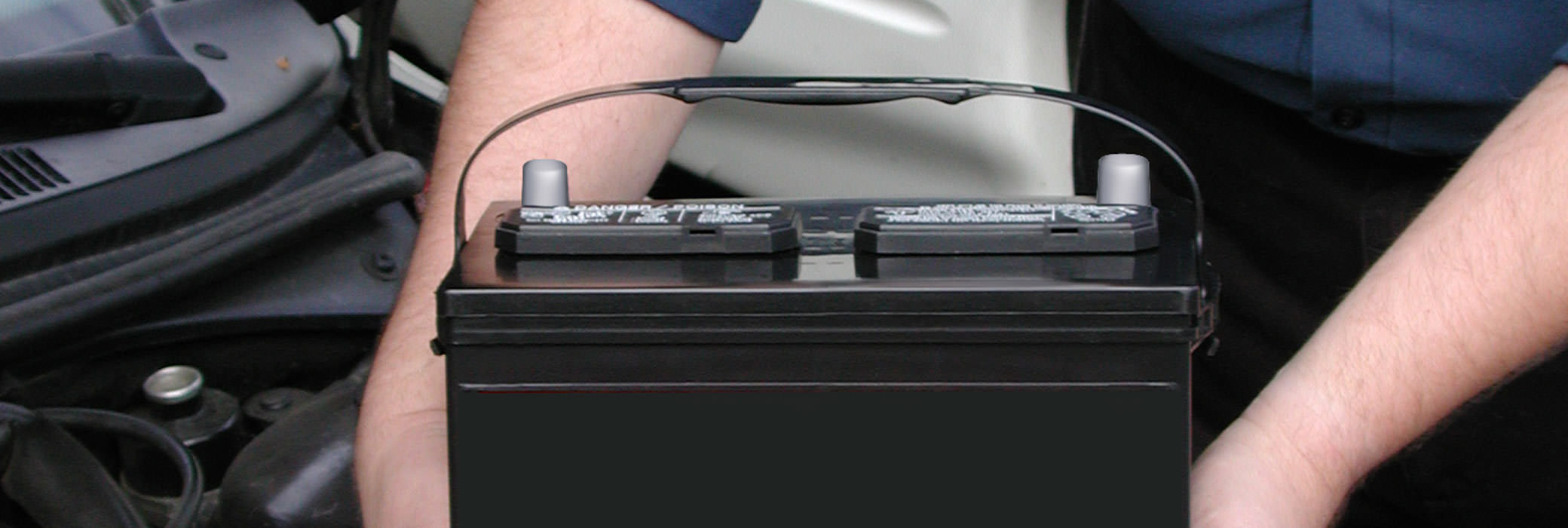
Step 1 - Prepare to Install Your Car Battery: To install your new battery, first make sure you never work on or near a battery without carefully adhering to all safety precautions and that you have all the proper tools to get the job done:
- Wrenches: Cable clamp nuts and side terminal connections should be loosened and tightened with the correct size wrench. Incorrect sizes can damage the points of contact and make the nuts and terminal connections difficult, sometimes impossible, to loosen or tighten.
- Cable Clamp Puller: The cable clamp puller is used to remove the cable clamp from the battery terminal after the clamp has been loosened. It prevents damage caused by lateral or twisting forces.
- Cable Clamp Spreader: The cable clamp spreader expands cable clamps after they have been removed from the terminals and allows them to be placed back on the terminals in their proper position without force.
- Tapered Terminal and Cable Clamp Cleaning Brush: This brush is designed to clean tapered battery terminals and the surfaces of lead die-cast cable clamps. Wire brushes should never be used on stamped-metal cable clamps since the brushes could wear away the corrosion-resistant surface.
- Scraper and Wire Brush: These can be used to remove dirt, corrosion, and rust from portions of the battery tray, the hold-down, and the hold-down bolts.
Step 2 - Select the Best Car Battery for You: The next step in proper battery installation is finding the right battery for your vehicle. Check your owner’s manual for the original equipment (OE) manufacturer’s recommendations for:
- Technology type
- Battery group size
- Cold cranking amps (CCA)
- Reserve capacity (RC)
- Amp hour/C20 capacity
Step 3 - Remove the Old Car Battery:
- Before removing the old battery, note the location of the positive battery terminal and mark the polarity on the positive cable. This will help you avoid installing the new battery in a reversed position.
- Read and follow the Safety and Handling information on this website before you begin.
- Disconnect the battery terminal cables by loosening the screws on the cable clamps. Remove the negative cable first, then the positive cable.
- Unfasten the battery hold-down strap. This is the metal strap that keeps the battery secured.
- Remove the battery hold-down strap and the two long screws.
- Pull up on the battery to remove it from the car, using care to keep the battery as upright as possible. This will minimize the possibility of spilling electrolyte and damaging other vehicle parts. Do not lift the battery by its terminals.
- Inspect the battery for possible damage or corrosion.
- Ensure proper disposal by returning it to the store or workshop where you purchased the replacement battery, or to any other spent battery drop-off location. Visit the Recycling Your Battery page on this site for more information.

Step 4 - Install the New Car Battery:
- Read and follow the Safety and Handling Information on this website.
- Clean the tray where the battery rests. Use steel wool or a wire brush to rub the metal clamps and remove any corrosion.
- Place your new battery in the battery tray (make sure your battery is fully charged). Make sure it faces the proper direction so that the positive and negative terminals line up with their corresponding cables. Secure the hold-down strap in its original position over the new battery, ensuring it is properly secure to prevent movement or vibration wear. Do not tighten the hold-down bracket too hard since this can damage the plastic case and cover.
- Attach both cables. Attach the positive (red) cable first, following with the negative (black) cable.
- Hand-tighten the nuts. Do not over tighten the terminal bolts; the following values are recommended:
- SAE (tapered) automotive terminal: 50 to 70 inch-lb.
- Side terminal (3/89 nut): 70 to 90 inch-lb.
- Threaded stud terminal: 120 to 180 inch-lb.
Car and Truck Battery Installation Tips:
- Check mounting surface for objects or protrusions that could cause damage or wear to the case or cover. The battery must be level in the tray. Make sure there are no foreign objects in the tray that could damage the battery.
- Replace cables and connectors that show signs of corrosion, rust, or other damage.
- Do not lift or handle the battery by its terminals.
- If using a dual-terminal battery (it has both top and side terminals), use top terminals for accessory hookups and vehicle starting. Only use battery side terminals for vehicle starting.
- Check for proper battery polarity with respect to vehicle specifications. “Ground” polarity is typically indicated. “Reversed” polarity can cause serious damage to your vehicle’s electrical system.
- The hold-down should be tightened so that it is snug.
- Top bar or top frame hold-down: 30 to 50 inch-lb.
- Bottom recess hold-down: 60 to 80 inch-lb.
- Bottom ledge-type hold-down: 70 to 90 inch-lb.
Caution: Some vehicles equipped with advanced electrical systems may require special handling procedures. Please refer to your owner’s manual for details.

Step 5 - Recycle the Old Battery: When your old battery has reached the end of its life, don’t hang onto it. Ensure proper disposal by returning it to the store or workshop where you purchased the replacement battery, or to any other spent battery drop-off location. Visit the Recycling Page on this site for more information.

